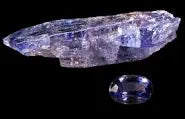
Discovering Tanzanite: A Gem of Rare Beauty
Geological Profile of Tanzanite
Tanzanite is a striking blue to violet variety of the mineral zoisite, with the formula . It was first identified in 1967 in northern Tanzania, near Mount Kilimanjaro, making it one of the most geographically limited gemstones in the world.
-
Crystal Structure: Orthorhombic, typically forming prismatic or tabular crystals.
-
Colour Range: Varies from sapphire-blue, violet-blue to blue-purple; pleochroic—meaning it shows different colours when viewed from different angles.
-
Formation Conditions: Originates in metamorphic environments, where hydrothermal activity has altered pre-existing rocks.
-
Notable Location: The spectacular specimens come exclusively from the Mererani Hills in Tanzania, making tanzanite remarkably rare.

Energetic Meaning & Healing Properties
Tanzanite is revered for its spiritual and mental healing properties:
-
Throat & Third-Eye Activation: Linked to enhancing communication and intuition, it encourages self-expression and clarity.
-
Emotional Balancing: Said to calm an overactive mind, helping with stress, anxiety, and emotional turbulence.
-
Spiritual Growth: Often used in meditation as a gateway to higher consciousness, it encourages deep insight and soul alignment.
These qualities make tanzanite a transformative crystal in holistic and spiritual practices.
Distinctive Natural Form & Collector’s Value
The rarity and pleochroic beauty of tanzanite contribute to its high value among collectors:
-
Undisturbed Crystals: Raw tanzanite specimens—especially with transparent zones and vibrant colours—are highly prized and often featured in mineral specimen jewellery.
-
Unique Character: In its natural state, inclusions or zoning add visual depth, making each piece unique.
-
Collector Appeal: Larger, high-grade tanzanite crystals are exceptionally scarce, elevating their appeal for collectors and museums.
Tanzanite in Jewellery: A Mineral Specimen's Statement
Tanzanite’s vivid hue and unique optical properties make it a jewel of choice in both refined and raw settings:
-
Raw Crystal Jewellery: When left uncut and in matrix, tanzanite holds an earthy elegance ideal for mineral specimen necklaces or crystal specimen rings.
-
Handmade Designs: Artisans often favour tanzanite for bespoke, handmade gemstone rings due to its alluring play of colour and spiritual symbolism.
-
Durability Note: While relatively hard (Mohs 6–7), tanzanite is more brittle than quartz or sapphire, necessitating care in everyday wear.
At Oryssia, our curation of raw mineral jewellery embraces the natural variance of each tanzanite piece, enhancing its wild charm and individuality.
Comparing Tanzanite to Similar Crystals
Tanzanite is often compared to other blue-violet stones but maintains a distinct identity:
-
Versus Sapphire: While both can appear similar in colour, sapphire is harder and more commonly found; tanzanite is more pleochroic and spiritually focused.
-
Versus Iolite: Iolite also shows pleochroism, but its tones are typically more muted. Tanzanite’s intensity and geological exclusivity set it apart.
-
Versus Amethyst: Amethyst leans towards purple and is more abundant, whereas tanzanite’s blue-violet hues and rare origin elevate its prestige.

Cultural Footnotes & Modern Lore
Though tanzanite lacks ancient myth due to its modern discovery, its connection to Mount Kilimanjaro and Maasai culture adds depth. It’s said the Maasai gave tanzanite as a gift at childbirth, honouring new life—a symbolic link to tanzanite’s association with transformation and rebirth.